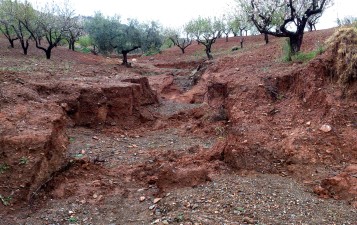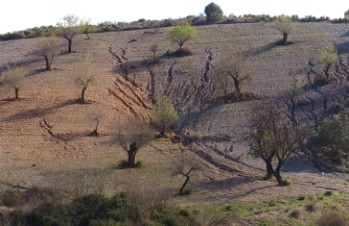



Within the EU FP6 RECONDES project the connectivity between different land units was studied, with emphasis on abandoned and semi-natural lands. By influencing connectivity (i.e. by increasing disconnectivity), water and sediment can be retained on-site, thereby reducing (or even preventing) further site degradation, loss of soil quality and water, as well as off-site sedimentation and flash flood problems. This can be achieved by applying appropriate re-vegetation strategies with endemic plants, and/or by improving land management strategies. Both strategies are the most effective when applied at degradation 'hot-spot' locations. This study was carried out in two regions within the Mediterranean that are under threat of desertification, viz. Murcia (SE Spain), representing the dry end of the spectrum of Mediterranean climates, and Tuscany (Italy), representing a more humid environment.
Within the EU Framework 5 ECOSLOPES project the possibilities of eco-engineering were researched with regard to problems of erosion, slope failure and tree uprooting. Field sites were studied in terms of slope failures and surface erosion in relation to land abandonment and natural re-vegetation of fields and slopes. Land abandonment influenced slope stability adversely, leading to slumping and mudflows. The role of water pathways and water availability in relation to the presence or absence of (tall) vegetation was studied as well as the role of roots with respect to soil mechanical properties. The change in soil and vegetation parameters as linked to degradation processes was studied across a natural vegetation succession on abandoned lands whereas the influence of roots on the improvement of slope stability was studied as well.
Semi-arid grasslands are often invaded by exotic shrubs. In Eastern South Africa we studied the role of Pteronia incana invading grasslands in terms of the loss of grass biomass, soil degradation and loss of soil material by increased hydrological connectivity between bare patches. This research was carried out in collaboration with local experts under a grant from NWO-SANPAD.
The high Andean neo-tropical sub-humid grassland ecosystems (jalca and puna) are under threat of degradation as a result of encroaching population and land-use change, increased water withdrawal and mining. Research is carried out in the Peruvian Andes within the context of the GEF-Worldbank funded Proyecto Paramo Andino, focusing on degradation of soils, the sequestration of carbon, water quality and geo-conservation.
Evaluation of current degradation rates relative to historical degradation rates becomes feasible by coupling current erosion rates at various levels of scale to proxy records of recent sediments as deposited in shallow reservoirs and historic rainfall data. Of special significance in this regard is the study of the production, transport and deposition of organic carbon. Also truncated soil profiles and calcrete layers are being used to assess past soil degradation rates. Field studies are underpinned by "state of the art" laboratory experiments. This work involves several MSc and PhD research projects.
Land abandonment may lead to increased soil degradation rates, especially shortly after abandonment.
There is also a clear development of vegetation patterns during natural vegetation succession on abandoned fields that have an impact on soil quality change and lead to increased heterogeneity in soil properties, including accumulation of organic carbon and nitrogen, surface infiltration rates, as well as soil bulk density and vulnerability to erosion (erodibility).
Time sequences of land abandonment are investigated to understand the associated changes in soil and vegetation properties, including spatial patterns.
In turn, these changes in soil and vegetation affect the hydrological and erosion response of the fields, particularly through changes in surface hydrological connectivity.
This work involves various MSc projects in connection with local researchers in Spain and Tenerife.